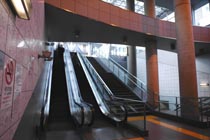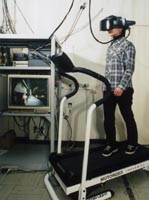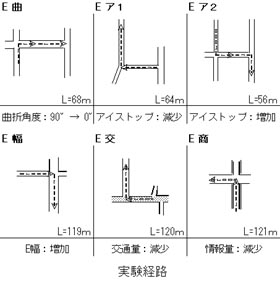|
 Passengers’ distance/depth perception along underground pathways around subway stations
Passengers’ distance/depth perception along underground pathways around subway stations
|
|
<Proceedings of the International Academic Conference on Underground Space,
pp. 97-102, Nov. 2006.><EBRA2004>
Ryuzo Ohno, Maiko Ogura, Masashi Soeda, Megumi Katayama
|
|
|
|


|
|
The new subway lines in the middle of Tokyo run very deep in the ground since they have to be constructed beneath already
existing subway lines. The passengers, therefore, must travel a long distance from the ground level to the platform. During their long
passage through underground paths, they may suffer from stress caused by feelings of claustrophobia and latent concerns for safety.
The present study examines the influence of environmental factors on distance/depth perception through a series of experiments
conducted along underground paths located near subway stations. Subjects (16 male and 11 female university students) were divided
into 8 groups each consisting of 3 or 4 people. Each subject group, accompanied by an experimenter, was asked to walk along two
underground paths that had different environmental features. Each subject was asked to estimate the ratio of the length of the
second path to the first one. At the same time, they were also asked to rate the overall atmosphere of the path. Seven such experimental
sessions were conducted using 12 paths around 3 subway stations in the middle of Tokyo. Physical characteristics of the paths such as width,
ceiling height, luminance and number of turns were either measured on site or taken from architectural drawings. The results of
the experiment generally support the hypothesis that certain pathway design features will influence distance/depth perception.
The experiment revealed that wider and more open paths tended to be judged shorter and set less deep underground. It was also found that
paths with more turns were judged longer, though this effect was not found for paths running through an atrium. As for the effect of the
overall atmosphere along the path, spaces that provided impressions of brightness, openness, cleanliness and safety made subjects judge
the paths to be shorter and less deep.
Full paper -> PDF
|
|
 A Study of distance perception using a visual simulator linked with walking
motion A Study of distance perception using a visual simulator linked with walking
motion
|
|
<Journal of Architecture, Planning and Environmental Engineering, Pp.95-100,
Dec. 2001>
Ryuzo Ohno, Megumi Katayama, Toshinori Komatsuzaki, Masashi Soeda
|
|
<New Impulses in Planning Process - Environmental Simulation: Proceedings of the 5th EAEA Conference, pp.24-34, 2002>
|
|
 
|
|
Conventional visual simulators allow observers to move in the simulated space by using a mouse or a joy-stick without the kinesthetic feeling of motion. However, the link between visual image and body motion is important to perceive the environment, especially when people are walking.
A visual simulator was developed to synchronize the subject's walking motion on the treadmill with the video image shown on a HMD. Its validity was examined by comparing the accuracy of distance estimation with the conventional video image without walking motion. The “distance reproduction” method was applied to measure the perceived distance: subjects walked 25 meter in a real setting without being told the distance, and were asked to move the same distance in different conditions. Since the distance estimation became accurate in the condition with the walking motion, the validity of this simulator was secured.
The following experiment was intended to investigate the influence of physical environmental features on perceived distance by using the simulation system. We operated some features using a scale model of a route and examined their influences. Subjects were asked to "walk" through a path consisted of two spaces with different physical features, and to respond by showing the proportion of the length of those two spaces. The result revealed that the distance of a narrower and lower ceiling path where people perceive clearer line perspective and faster optical flow tends to be perceived longer.
|
|
 A Study of the Physical Factors Influencing Pedestrian's Distance Perception
A Study of the Physical Factors Influencing Pedestrian's Distance Perception
|
|
<Proceedings of 18th Conference of the International Association for People-Environment Studies, Jul. 2004.>
|
| Megumi Katayama, Ryuzo Ohno |
|

|
|
The purpose of this study was to determine the physical factors that influence a pedestrian's distance perception on urban streets.
This study consists of two stages. In Experiment 1, five commuting routes were selected, and the subjects were instructed to estimate the distances
of intervals with different atmospheres. The following results were found. 1) walking time; overestimation of the routes taking longer time caused
by obstacles and a crowd. 2) spaciousness; underestimation in wide and extensive place. 3) energy load; overestimation caused by upward slopes and
stairs. 4) information load; overestimation in stairs. In Experiment 2, an experiment was conducted to investigate the influences of spaciousness
and the visual information amount using a visual simulator in which the subjects walked through model spaces with different widths, heights, and visual
information amounts. The results indicate that people who is walking through a narrower and lower ceiling
path perceive a much clearer liner perspective image
and a faster optical flow, thus they tend to perceive much longer.
|
TOPへ
|